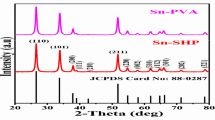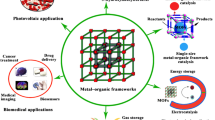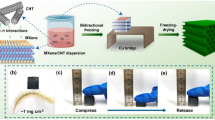Abstract
Purpose
To explain thermal stability enhancement of an organic compound, sucralose, with cyclodextrin based metal organic frameworks.
Methods
Micron and nanometer sized basic CD-MOFs were successfully synthesized by a modified vapor diffusion method and further neutralized with glacial acetic acid. Sucralose was loaded into CD-MOFs by incubating CD-MOFs with sucralose ethanol solutions. Thermal stabilities of sucralose-loaded basic CD-MOFs and neutralized CD-MOFs were investigated using thermogravimetric analysis (TGA), differential scanning calorimetry (DSC) and high performance liquid chromatography with evaporative light-scattering detection (HPLC-ELSD).
Results
Scanning electron microscopy (SEM) and powder X-ray diffraction (PXRD) results showed that basic CD-MOFs were cubic crystals with smooth surface and uniform sizes. The basic CD-MOFs maintained their crystalline structure after neutralization. HPLC-ELSD analysis indicated that the CD-MOF crystal size had significant influence on sucralose loading (SL). The maximal SL of micron CD-MOFs (CD-MOF-Micro) was 17.5 ± 0.9% (w/w). In contrast, 27.9 ± 1.4% of sucralose could be loaded in nanometer-sized basic CD-MOFs (CD-MOF-Nano). Molecular docking modeling showed that sucralose molecules preferentially located inside the cavities of γ-CDs pairs in CD-MOFs. Raw sucralose decomposed fast at 90°C, with 86.2 ± 0.2% of the compound degraded within only 1 h. Remarkably, sucralose stability was dramatically improved after loading in neutralized CD-MOFs, with only 13.7 ± 0.7% degradation at 90°C within 24 h.
Conclusions
CD-MOFs efficiently incorporated sucralose and maintained its integrity upon heating at elevated temperatures.









Similar content being viewed by others
Abbreviations
- CD-MOFs:
-
Cyclodextrin metal organic frameworks
- CTAB:
-
Cetyl trimethyl ammonium bromide
- DSC:
-
Differential scanning calorimetry
- EtOH:
-
Ethanol
- HPLC-ELSD:
-
High performance liquid chromatography with evaporative light-scattering detection
- MeOH:
-
Methanol
- PXRD:
-
Powder X-ray diffraction
- TGA:
-
Thermogravimetric analysis
- γ-CD:
-
γ-cyclodextrin
References
Horcajada P, Gref R, Baati T, Allan PK, Maurin G, Couvreur P, et al. Metal-organic frameworks in biomedicine. Chem Rev. 2012;112(2):1232–68.
Lin WB. Nanoscale metal-organic frameworks for biomedical imaging and drug delivery. Abstr Papers Am Chem Soc. 2014;248.
Sun CY, Qin C, Wang XL, Su ZM. Metal-organic frameworks as potential drug delivery systems. Expert Opin Drug Deliv. 2013;10(1):89–101.
Horcajada P, Serre C, Vallet-Regi M, Sebban M, Taulelle F, Ferey G. Metal-organic frameworks as efficient materials for drug delivery. Angew Chem Int Ed. 2006;45(36):5974–8.
Horcajada P, Chalati T, Serre C, Gillet B, Sebrie C, Baati T, et al. Porous metal-organic-framework nanoscale carriers as a potential platform for drug delivery and imaging. Nat Mater. 2010;9(2):172–8.
Chalati T, Horcajada P, Couvreur P, Serre C, Ben Yahia M, Maurin G, et al. Porous metal organic framework nanoparticles to address the challenges related to busulfan encapsulation. Nanomedicine. 2011;6(10):1683–95.
Kundu T, Mitra S, Patra P, Goswami A, Diaz DD, Banerjee R. Mechanical downsizing of a gadolinium(III)-based metal-organic framework for anticancer drug delivery. Chem Eur J. 2014;20(33):10514–8.
Sun CY, Qin C, Wang CG, Su ZM, Wang S, Wang XL, et al. Chiral nanoporous metal-organic frameworks with high porosity as materials for drug delivery. Adv Mater. 2011;23(47):5629.
Ananthoji R, Eubank JF, Nouar F, Mouttaki H, Eddaoudi M, Harmon JP. Symbiosis of zeolite-like metal-organic frameworks (rho-ZMOF) and hydrogels: composites for controlled drug release. J Mater Chem. 2011;21(26):9587–94.
Taylor-Pashow KML, Della Rocca J, Xie ZG, Tran S, Lin WB. Postsynthetic modifications of iron-carboxylate nanoscale metal-organic frameworks for imaging and drug delivery. J Am Chem Soc. 2009;131(40):14261.
Smaldone RA, Forgan RS, Furukawa H, Gassensmith JJ, Slawin AMZ, Yaghi OM, et al. Metal-organic frameworks from edible natural products. Angew Chemie Int Ed. 2010;49(46):8630–4.
Su H, Sun F, Jia J, He H, Wang A, Zhu G. A highly porous medical metal-organic framework constructed from bioactive curcumin. Chem Commun. 2015;51(26):5774–7.
Sontz PA, Bailey JB, Ahn S, Tezcan FA. A metal organic framework with spherical protein nodes: rational chemical design of 3D protein crystals. J Am Chem Soc. 2015;137(36):11598–601.
Yin F, Chen J, Liang Y, Zou Y, Yinzhi J, Xie J. Syntheses, structures, and properties of Co(II)/Zn(II) mixed-ligand coordination polymers based on 4-[(3,5-dinitrobenzoyl)amino]benzoic acid and 1,4-bis(1-imidazolyl) benzene. J Solid State Chem. 2015;225:310–4.
Agostoni V, Horcajada P, Noiray M, Malanga M, Aykaç A, Jicsinszky L, et al. A “green” strategy to construct non-covalent, stable and bioactive coatings on porous MOF nanoparticles. Sci Rep. 2014;5:7925.
Han SB, Wei YH, Valente C, Forgan RS, Gassensmith JJ, Smaldone RA, et al. Imprinting chemical and responsive micropatterns into metal-organic frameworks. Angew Chemie Int Ed. 2011;50(1):276–9.
Gassensmith JJ, Kim JY, Holcroft JM, Farha OK, Stoddart JF, Hupp JT, et al. A metal-organic framework-based material for electrochemical sensing of carbon dioxide. J Am Chem Soc. 2014;136(23):8277–82.
Yoon SM, Warren SC, Grzybowski BA. Storage of electrical information in metal-organic-framework memristors**. Angew Chemie Int Ed. 2014;53(17):4437–41.
Gassensmith JJ, Furukawa H, Smaldone RA, Forgan RS, Botros YY, Yaghi OM, et al. Strong and reversible binding of carbon dioxide in a green metal-organic framework. J Am Chem Soc. 2011;133(39):15312–5.
Forgan RS, Smaldone RA, Gassensmith JJ, Furukawa H, Cordes DB, Li QW, et al. Nanoporous carbohydrate metal-organic frameworks. J Am Chem Soc. 2012;134(1):406–17.
Moussa Z, Hmadeh M, Abiad MG, Dib OH, Patra D. Encapsulation of curcumin in cyclodextrin-metal organic frameworks: dissociation of loaded CD-MOFs enhances stability of curcumin. Food Chem. 2016;212:485–94.
Sharma VK, Oturan M, Kim H. Oxidation of artificial sweetener sucralose by advanced oxidation processes: a review. Environ Sci Pollut Res. 2014;21(14):8525–33.
Rocha-Selmi GA, Theodoro AC, Thomazini M, Bolini HMA, Favaro-Trindade CS. Double emulsion stage prior to complex coacervation process for microencapsulation of sweetener sucralose. J Food Eng. 2013;119(1):28–32.
Quinlan ME, Jenner MR. Analysis and stability of the sweetener sucralose in beverages. J Food Sci. 1990;55(1):244–6.
de Oliveira DN, De MM, Catharino RR. Thermal degradation of sucralose: a combination of analytical methods to determine stability and chlorinated byproducts. Scientific Reports. 2015;5.
Cherukuri SR, Wong LL. Stabilized sucralose complex. In.: US; 1990.
Alai MS, Lin WJ. A novel nanoparticulate system for sustained delivery of acid-labile lansoprazole. Colloids Surf B: Biointerfaces. 2013;111:453–9.
Trott O, Olson AJ. Trott, O and Olson, AJ. AutoDock Vina: improving the speed and accuracy of docking with a new scoring function, efficient optimization, and multithreading. J Comput Chem. 2009;31(2):455–61.
Furukawa Y, Ishiwata T, Sugikawa K, Kokado K, Sada K. Nano- and microsized cubic Gel particles from cyclodextrin metal-organic frameworks. Angew Chemie Int Ed. 2012;51(42):10566–9.
Beatriz Brizuela A, Beatriz Raschi A, Victoria Castillo M, Leyton P, Romano E, Antonia BS. Theoretical structural and vibrational properties of the artificial sweetener sucralose. Comput Theor Chem. 2013;1008:52–60.
Oliveira DND, Menezes MD, Catharino RR. Thermal degradation of sucralose: a combination of analytical methods to determine stability and chlorinated byproducts. Scientific Reports. 2015;5.
ACKNOWLEDGMENTS AND DISCLOSURES
The authors are grateful for the financial support from the National Natural Science Foundation of China (No. 81430087) and National Science and Technology Major Project (2013ZX09402103).
Author information
Authors and Affiliations
Corresponding authors
Additional information
Equally contributing authors (N.L. for drug loading, experiments other than HPLC and preparation of the manuscript; T.G. for molecular simulation; B.L. for CD-MOFs preparation; C.W. for HPLC method establishment and validation).
Nana Lv, Tao Guo, Botao Liu and Caifen Wang contributed equally to this work.
Electronic supplementary material
Below is the link to the electronic supplementary material.
ESM 1
(DOCX 252 kb)
Rights and permissions
About this article
Cite this article
Lv, N., Guo, T., Liu, B. et al. Improvement in Thermal Stability of Sucralose by γ-Cyclodextrin Metal-Organic Frameworks. Pharm Res 34, 269–278 (2017). https://doi.org/10.1007/s11095-016-2059-1
Received:
Accepted:
Published:
Issue Date:
DOI: https://doi.org/10.1007/s11095-016-2059-1




